Japan is a country where ancient traditions and cutting-edge technology live side by side. As one of Asia’s most technologically advanced nations, it’s fantastic there’s a treasure trove of shrines, temples and castles too. These historical landmarks in Japan are revered even though Japan’s megacities continue to grow at lightning speed. There are thousands of landmarks in Japan in the cities and throughout the countryside.
From beautiful Mount Fuji to instantly recognisable historic landmarks like the Fushimi Inari shrine and Osaka Castle, these quintessential Japanese landmarks are worthy of your time. Japan has a good mixture of icons that piece together the intriguing puzzle of a fascinating nation and the diversity of Japan’s best monuments is part of the experience itself. You’ll crane your neck to get a look at a modern skyscraper while just around the corner is a temple that is centuries old. You’ll want to add some of these amazing landmarks to your Japan itinerary, for sure.
Contents
21 Japan Landmarks For Your Bucket List
Top 3 Landmarks in Japan
Whether you’re visiting Japan in winter, spring, summer or autumn, these three classic landmarks will impress any time of the year.
1- Mount Fuji
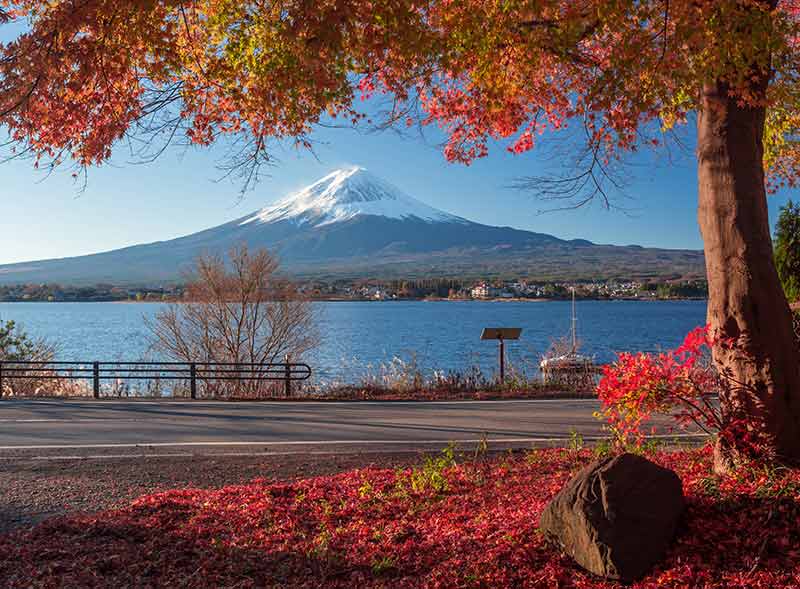
Inspiring poets and artists for centuries, Mount Fuji is possibly the most famous of all the landmarks in Japan.
You can see the stunning mountain from many places in and around Tokyo but if looking at this iconic Japanese landmark is not enough, try climbing it.
Join thousands of people and climb Mount Fuji for an experience to remember for the rest of your life.
One of the best places to gaze at Mount Fuji is from Hakone, where the Japanese onsen experience is something you must try while in Japan.
Mount Fuji is at Kitayama, Fujinomiya, Shizuoka. You can get there by bus or train and the closest airport is Mount Fuji Shizuoka Airport.
2- Atomic Bomb Dome
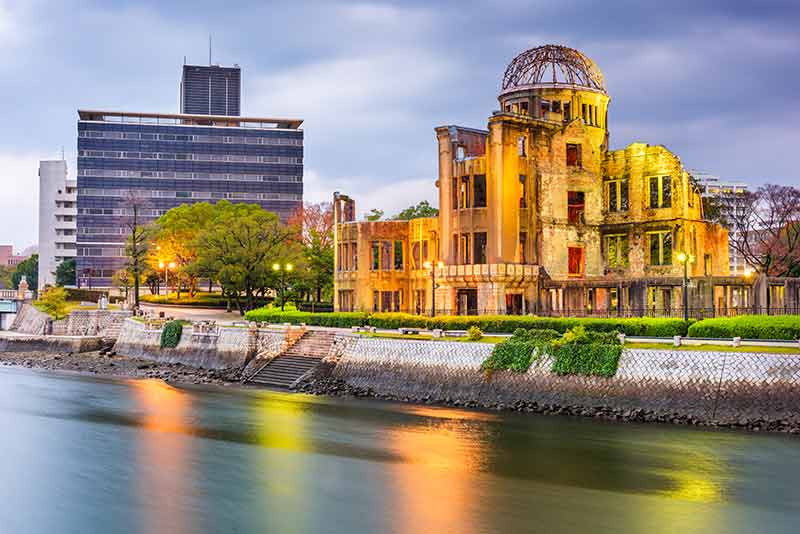
The Atomic Bomb Dome or A-Bomb Dome or Hiroshima Peace Memorial goes by several names but whatever you choose to call it, it’s is a sober reminder of a significant historical event that changed the course of Japan’s history.
Not only did the bombing of Hiroshima and Nagasaki affect Japan, but it also shaped the history of the world.
The first atomic bomb in the history of the world (and hopefully the last) was dropped on Hiroshima at 8. 15 am on 6 August 1945.
The Atomic Bomb Dome was directly beneath the explosion but miraculously wasn’t destroyed.
Located in Hiroshima’s Peace Memorial Park, which was a commercial and political hub before the bombing, the A-Bomb Dome was one of the few buildings to remain standing after the event.
Today, it’s a UNESCO World Heritage Site and a unique landmark in Japan that everyone should see along with visiting the Cenotaph for Atomic Bomb Victims and the Hiroshima Peace Memorial Museum.
The A-Bomb Dome is at 1-10 Otemachi, Naka Ward, Hiroshima.
3- Tokyo Skytree
A landmark of Japan’s dominance in the television broadcasting era, Tokyo Skytree is the tallest tower in the world (a tower has usable floor space for less than half its height) but isn’t classified as a skyscraper.
At 634m tall, it’s twice the height of the Eiffel Tower and was designed by the same firm in Japan that was responsible for creating the 333m high Tokyo Tower in 1958.
When it was completed in 2012, it was the tallest structure in the world.
Located in Sumida Ward, it has a large shopping complex and an aquarium at its base.
There are observation decks at 350m and 450m as well as a spiralling corridor at 451m, all with spectacular views of Tokyo.
Tokyo Skytree is at 1 Chome-1-2 Oshiage, Sumida City, Tokyo 131-0045, Japan. It’s open daily from 9 am to 10 pm.
Top Landmarks Around The World:
Discover more Famous World Landmarks:
- 25 Australian Landmarks
- 20 New Zealand Landmarks
- 20 African Landmarks
- 21 Egyptian Landmarks
- 20 Jordan Landmarks
- 10 Tasmanian Landmarks
- 20 Antarctica Landmarks
Tokyo Landmarks
It’s not surprising that Japan’s capital has more eye-catching landmarks than any other city.
Landmarks in Tokyo are a breathtaking mix of old and new, showing off Tokyo’s blend of ancient culture while it keeps its focus on a bright future.
4- The Imperial Palace in Tokyo
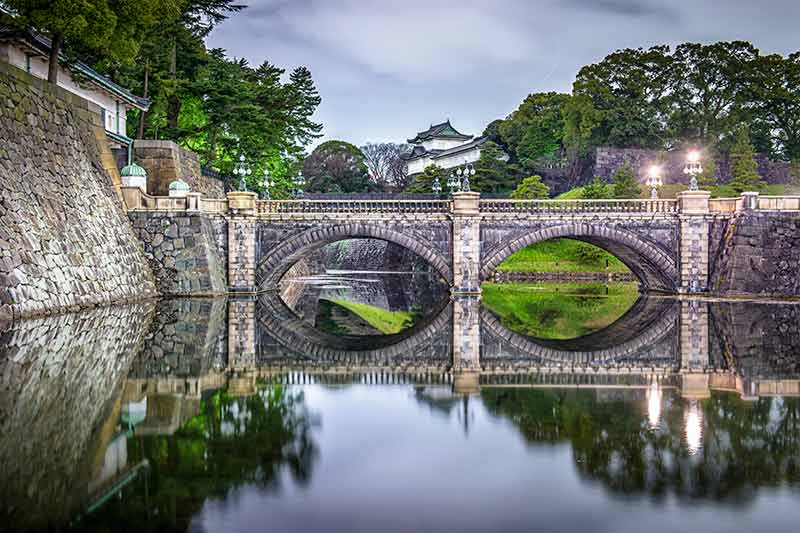
One of the unusual features of the Tokyo Imperial Palace, which is one of the most famous historic landmarks in Japan, is its location.
The palace is right in the centre of one of the most modern cities in the world and just a short walk from the Tokyo railway station.
Another interesting fact about the Imperial Palace is it sits on the grounds where Edo Castle, which was the stronghold of the Meiji Shoguns, once stood.
Surrounded by a moat and lovely tree-covered grounds, the Imperial Palace is not just a Tokyo landmark to be ogled at but a place where you can soak up centuries of history.
There’s plenty to see on the 3.41 km2 sprawling grounds including the Imperial Palace and three impressive gardens – Kitanomaru Garden, Kōkyo Higashi Gyoen and Kokyogaien National Garden.
The gardens are open to the public and you can visit the private grounds on 2 January and during the Emperor’s Birthday on 23 December.
5- Shibuya Crossing
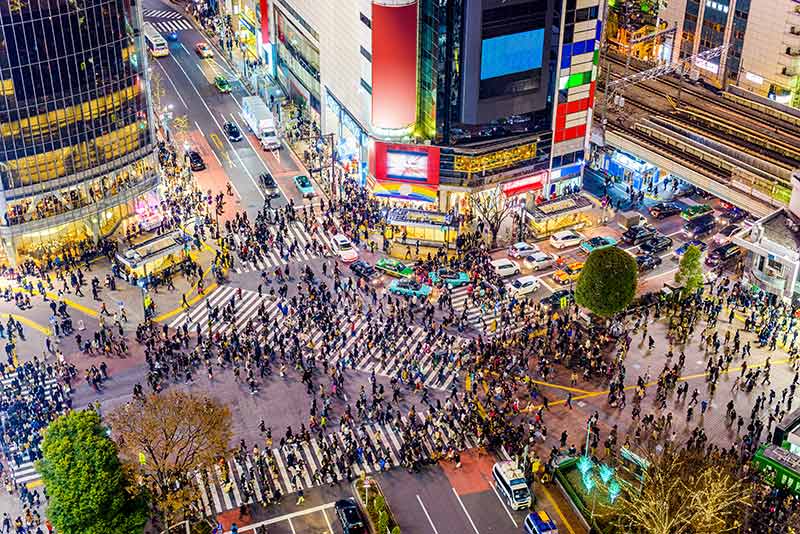
The main reason why Shibuya Crossing is a landmark in Japan is that this is one of the busiest intersections in the world.
More than 250,000 people use this crossing every day, scrambling across to get off the road within two minutes.
It’s an exhilarating experience to cross with thousands of pedestrians and the skyscrapers and flashing billboards add to the excitement.
It’s such an iconic place in Japan that many people have proposed at this intersection.
A great vantage point to watch the action is from the Starbucks on the second floor of Shibuya Tsutaya but you’ll have to fight the crowd for a window seat.
Shibuya Crossing is at Shibuya, Tokyo near Shibuya Station’s Hachiko Exit.
6- Tokyo Tower
Before Tokyo Skytree was built, Tokyo Tower held the crown as one of the most recognisable modern landmarks in Japan’s largest city.
There’s a bit of nostalgia and romance surrounding the tower, which was modelled along with the lines of the Eiffel Tower and at 333m, it’s 13 m higher than the Paris landmark.
The observation deck at 150 m has a lovely view of the city and another higher deck at 250 m with a panoramic bird’s eye view of Tokyo.
This is Tokyo’s third-highest observation deck and a good place for a view of both Tokyo Skytree and Mount Fuji.
Tokyo Tower is at 4 Chome-2-8 Shibakoen, Minato City, Tokyo 105-0011, Japan. It’s open from 9 am to 11 pm.
7- Hachiko Statue
Near Shibuya Crossing is a quirky landmark in Tokyo, which has become a popular meeting point.
Dog lovers will be happy to learn that the Hachiko Statue pays homage to a canine, the most loyal dog in Japan.
As the story goes, back in the 1920s, this Akita dog would run to meet its owner at Shibuya Station upon his arrival back home from his daily commute.
When his died of a cerebral haemorrhage, the dog continued to return to the same spot for nine years in the hope that his owner would one day return.
The reason the Hachiko Statue of the dog is a Tokyo landmark is that it’s a heart-warming reminder of the qualities that make life worth living – loyalty, companionship and determination.
Hachiko Statue is at 2-1 Dogenzaka, Shibuya City, Tokyo.
More Landmarks in Asia:
Kyoto Landmarks
Landmarks in Kyoto are quintessentially Japanese and many are instantly recognisable around the world.
One of the reasons why Kyoto is a crowd puller is that it has so many of Japan’s famous landmarks to see.
8- Arashiyama Bamboo Grove
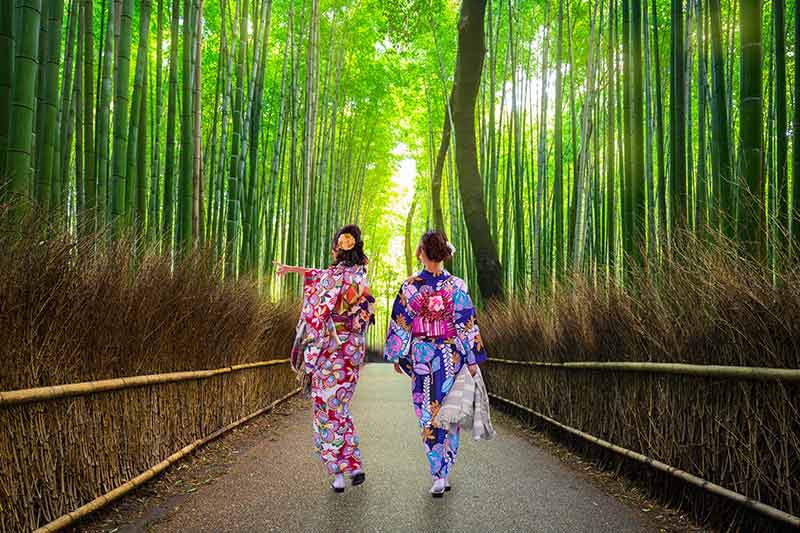
Arashiyama bamboo grove attracts visitors who come to marvel at the bamboo forest at the foot of the Arashiyama mountains to the west of Kyoto.
It’s a mystical bamboo forest that has become a Kyoto landmark as photographers continue to capture its beauty to show the world.
The path rises gently uphill and is a cool and calming walk that will give you a sense of the spiritual nature of the region.
9- Fushimi Inari Taisha
A string of vermillion torii gates starts the hike leading up to one of the most famous Kyoto landmarks of all, Fushimi Inari Shrine.
Walking beneath one of these two rows of tori gates is one that makes the Fushimi Inari shrine a unique landmark in Japan.
Dedicated to Inari, the Shinto god of rice, you’ll feel like you’re in another world as a Japanese torii gate is a doorway between the physical and spiritual worlds.
Fushimi Inari’s torii gates were donated by those who believe and the number of torii gates here is will take your breath away.
It’s easy to see why the Shinto shrine has become one of Japan’s most famous tourist spots.
Fushimi Inari shrine is at 68 Fukakusa Yabunouchicho, Fushimi, Kyoto and is near Inari station.
10- Kinkaku-ji
Another famous landmark in Kyoto, Kinkaku-ji (or Golden Pavilion), is well-named for its beauty.
The Zen Buddhist temple is smothered in gold leaf.
The sight of the temple, along with its reflection in the pond beside it, is an icon of Japan.
You might be surprised to learn that this traditional Japanese landmark is a reconstruction of what was originally the home of Shogun Ashikaga Yoshimitsu.
When the Shogun died, it was turned into a temple but burned down twice and had to be rebuilt following the original design.
Kinkaku-ji is at 1 Kinkakujicho, Kita, Kyoto.
For more amazing European Landmarks, read:
- 30 Spain Landmarks
- 20 Switzerland Landmarks
- 22 Germany Landmarks
- 35 London Landmarks
- 30 France Landmarks
- 20 Italy Landmarks
- 20 Greece Landmarks
- 20 Russia Landmarks
- 20 Scotland Landmarks
- 20 Ireland Landmarks
- 21 Wales Landmarks
- 20 Turkey Landmarks
- 20 England Landmarks
- 20 Hungary Landmarks
- 21 Romania Landmarks
- 20 Ukraine Landmarks
- 20 Athens Landmarks
- 20 Rome Landmarks
- 20 England Landmarks
- 20 Portugal Landmarks
- 20 Poland Landmarks
- 20 Iceland Landmarks
- 20 Bulgaria Landmarks
- 21 Croatia Landmarks
- 20 Bulgaria Landmarks
- 20 Austria Landmarks
- 21 Finland Landmarks
- 20 Sweden Landmarks
- 20 Denmark Landmarks
- 20 Belgium Landmarks
- 20 Netherlands Landmarks
- 20 Barcelona Landmarks
- 21 Czech Republic Landmarks
- 20 Landmarks in Paris
- 20 Landmarks in Liverpool
- 10 Istanbul Landmarks
Osaka Landmarks
Like Tokyo, Osaka is a city that conjures images of Shoguns and the romantic era of Japanese culture but Osaka is also a city that is well and truly leading the charge into the future.
So it’s not surprising there’s a decent choice of awesome landmarks to put on your Osaka itinerary.
Two of Osaka’s famous landmarks represent past and present in an impressive show of the city’s position within Japan.
11- Osaka Castle
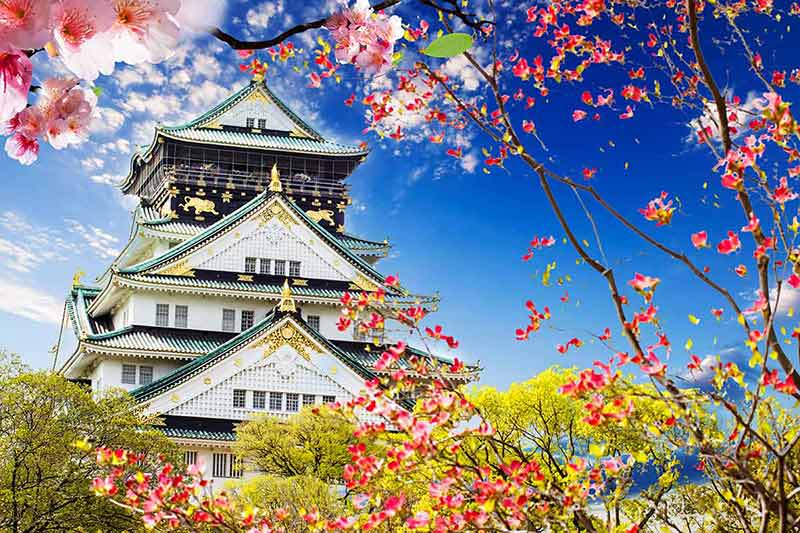
There are plenty of good reasons why Osaka Castle is one of the most famous landmarks in Japan.
Not only is the five-story castle visually spectacular, it also has a rich history that takes you back 450 years to the Sengoku period.
In 1583, feudal lord Hideyoshi Toyotomi built Osaka Castle to secure a stronghold in the region following a period of war.
Hence, Osaka Castle is a symbol of peace as it cemented his rule and led to a time of peace for a while.
The fairy tale castle has lovely sprawling grounds and is a delight to see both day and night.
Osaka Castle is at 1-1 Osakajo, Chuo Ward, Osaka.
12- Abeno Harukas
The tallest building in Japan is Abeno Harukas in Osaka, a fact that most people are surprised to learn.
The 300 m tall skyscraper rises into the sky above the Kintetsu Osaka Abenobashi Station and is home to a hotel, art museum and department store.
The Harukas 300 observation decks occupy the top three levels of the building, from the 58th to the 60th floors.
Gazing out through floor-to-ceiling glass panels or admiring the 360-degree view of Osaka from the 60th floor is an experience for your bucket list.
Abeno Harukas is across the road from JR Tennoji Station at 1 Chome-1-43 Abenosuji, Abeno Ward, Osaka.
13- Dōtombori i Running Man Sign
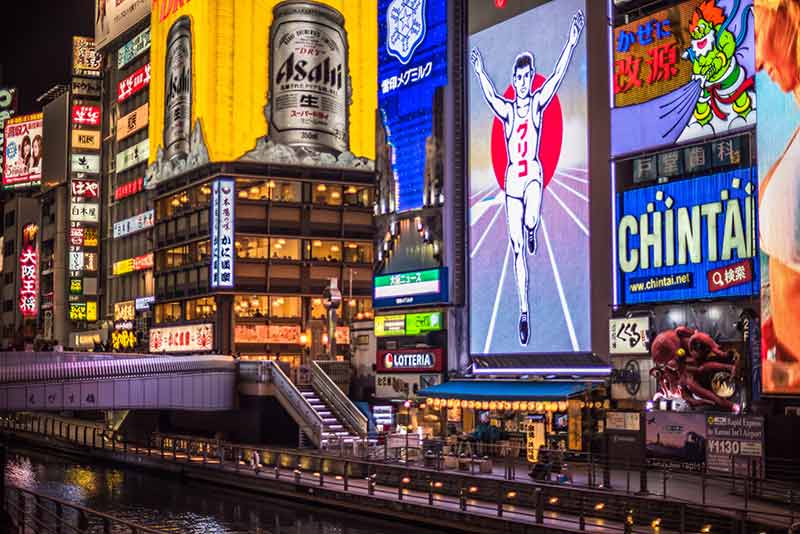
A dazzling landmark of Osaka’s contemporary culture, the Glico Man sign at the Ebusu-bashi Bridge is a corner of Osaka that everyone knows.
Dōtombori–dori is the place to go for bright lights at night, where massive billboards and TV screens flash like a scene in Blade Runner.
Amidst this neon forest is one sign that has lasted for over 70 years.
Even though it’s a simple image of a victorious athlete, the 33m Glico Man sign has become an icon.
The electronic billboard belongs to a confectionery manufacturer that makes popular caramel candy and Pocky pretzel snacks.
Once you’ve seen these top landmarks, head out on some day trips from Osaka for more Japanese delights.
Also read:
- 20 USA Landmarks
- 23 Canada Landmarks
- 22 Ohio Landmarks
- 21 Arizona Landmarks
- 21 Minnesota Landmarks
- 21 Oregon Landmarks
- 21 Illinois Landmarks
- 21 Colorado Landmarks
- 21 Georgia Landmarks
- 21 Michigan Landmarks
- 23 Los Angeles Landmarks
- 21 Washington Landmarks
- 21 Maryland Landmarks
- 20 Manitoba Landmarks
- 20 Kansas Landmarks
- 21 New Mexico Landmarks
- 20 Idaho Landmarks
- 20 Montana Landmarks
- 20 Oklahoma Landmarks
- 21 Wisconsin Landmarks
- 20 Tennessee Landmarks
- 21 Iowa Landmarks
- 20 Alaska Landmarks
- 20 Miami Landmarks
- 21 West Virginia Landmarks
- 21 Kentucky Landmarks
- 20 Louisiana Landmarks
- 21 Arkansas Landmarks
- 20 Cincinnati Landmarks
- 20 San Antonio Landmarks
- 25 Indiana Landmarks
- 21 New York Landmarks
- 20 Texas Landmarks
- 21 Boston Landmarks
- 20 Florida Landmarks
- 20 Hawaii Landmarks
- 5 South Dakota Landmarks
- 21 Pennsylvania Landmarks
- 23 New Jersey Landmarks
- 21 Virginia Landmarks
- 21 North Carolina Landmarks
- 21 Utah Landmarks
- 21 Nevada Landmarks
- 20 Massachusetts Landmarks
- 20 Washington DC Landmarks
- 20 Vermont Landmarks
- 20 Nebraska Landmarks
- 20 North Dakota Landmarks
- 21 Missouri Landmarks
- 20 Rhode Island Landmarks
- 21 Maine Landmarks
- 21 Connecticut Landmarks
- 20 San Diego Landmarks
- 20 Landmarks In South Carolina
- 20 Mississippi Landmarks
- 20 Las Vegas Landmarks
- 20 Dallas Landmarks
- 20 Houston Landmarks
- 20 Seattle Landmarks
Other landmarks in Japan
14- Tetsujin 28-go Robot
The Tetsujin 28-go is a giant robot erected in 2009 as a landmark in Kōbe.
Tetsujin 28-go was the Japanese manga comic character that inspired Gigantor, a flying robot controlled by remote control by a boy, in the 1960s.
Tetsujin 28-go was created by Kobe artist Mitsuteru Yokoyama.
After the Kobe earthquake in 1995 that caused 100 billion dollars of damage and where over 6,000 people perished, the 18m statue was built as a symbol of strength and hope.
Costing US$1.4 million dollars to build and weighing about 50 tons, it’s a Japan landmark that attracts droves of visitors to Kobe.
The Tetsujin 28-go is in Kobe.
15- Akashi Kaikyo Bridge
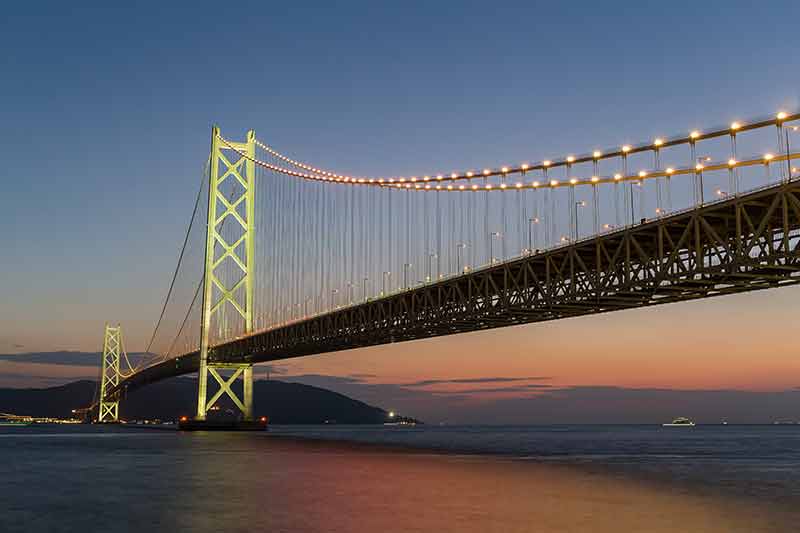
Another famous Japan landmark in Kobe, the Akashi-Kaikyo Bridge stretches across Akashi Strait between Kobe and Awaji Island.
Completed in 1998, the world’s longest suspension bridge has six lanes and a total length of 3,911 m.
Akashi-Kaikyo Bridge was constructed under severe natural conditions.
The Bridge was built to resist winds of 80m/sec and earthquakes.
Akashi Kaikyo Bridge is at 4 Higashimaikocho, Tarumi Ward, Kobe, Hyogo.
16- Himeji Castle
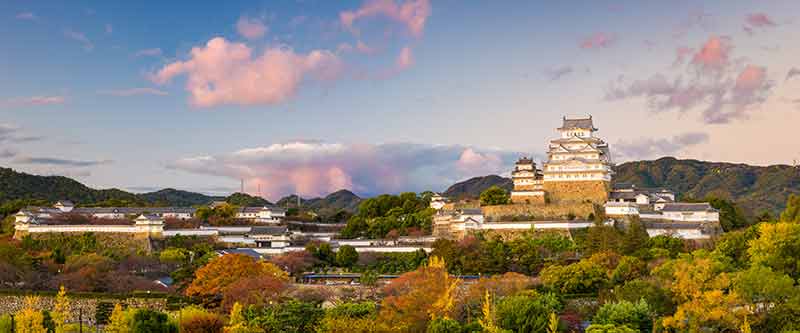
One of Japan’s most famous castles, Himeji Castle is a Japanese landmark that showcases the architecture of the Edo era.
Most people recognise this castle because it was featured in the Last Samurai, starring Tom Cruise.
It’s the largest castle in Japan and a UNESCO World Heritage Site initially built in the 14th century but rebuilt several times after fires and earthquakes.
The castle is also known as White Egret Castle or White Heron Castle because of the stark white colour of the castle and its shape resembling a flying bird.
Himeji Castle is at 68 Honmachi, Himeji, Hyogo near Himeji station.
17- Itsukushima Shrine’s O-Torii gate
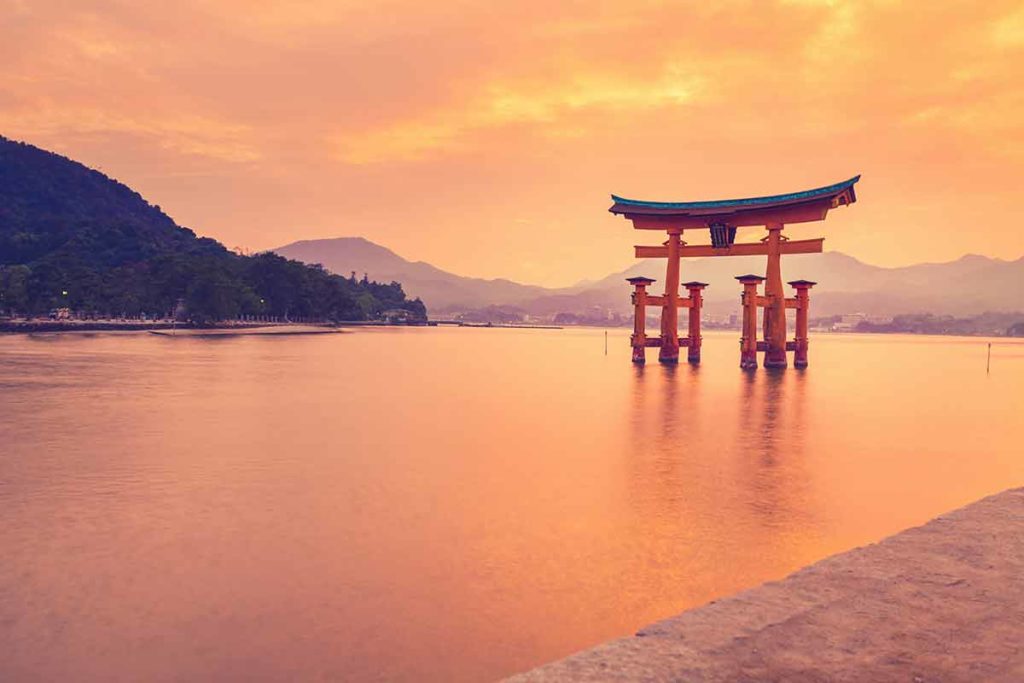
Itsukushima Shrine’s O-Torii gate is one of the most photographed landmarks in Japan.
Located on Miyajima Island, the shrine is a mystical place to visit in Japan and at high tide, the O-Torii gate adds to its mystery as it looks like it’s floating on the sea.
This holy Shinto shrine is shrouded in mystery and was closed to the public (Itsukushima means “island of worship”).
Now a UNESCO World Heritage Site, the shrine has a history that stretches back for over 1400 years.
The main shrine is connected to smaller shrines and each is dedicated to several Shinto deities.
During low tide, you can walk up to the tori gate but from March to November, it’s possible to cruise under the O-Torii gate in a boat.
The custom is to bow twice, clap twice then bow again as you pass under the O-Torii gate.
Itsukushima Shrine is at 1-1 Miyajimacho, Hatsukaichi, Hiroshima.
18- Shirakawa-go
A UNESCO World Heritage Site, the picturesque village of Shirakawa-go form a pretty picture.
The A-frame houses of Shirakawa-go covered with a blanket of snow make this a giant landmark to see in winter.
19- Ushiku Daibutsu
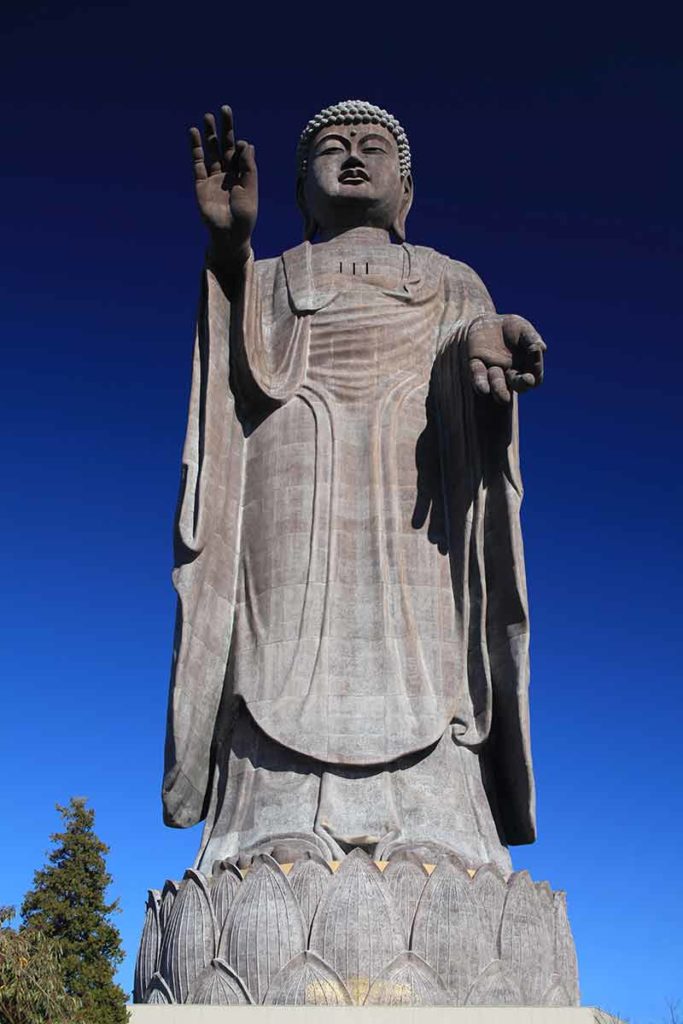
Ushiku Daibutsu (Daibutsu means “great Buddha”) is a stunning landmark in Japan and the tallest Buddha statue in the country.
A creation of the 20th century, the 120 cm (390 ft) tall monument held the record for being the tallest statue in the world between 1993 and 2008.
It’s still one of the world’s tallest statues, with four levels and a museum inside the statue.
Ushiku Daibutsu is at 2083 Kunocho, Ushiku, Ibaraki.
20- Kamakura Daibutsu
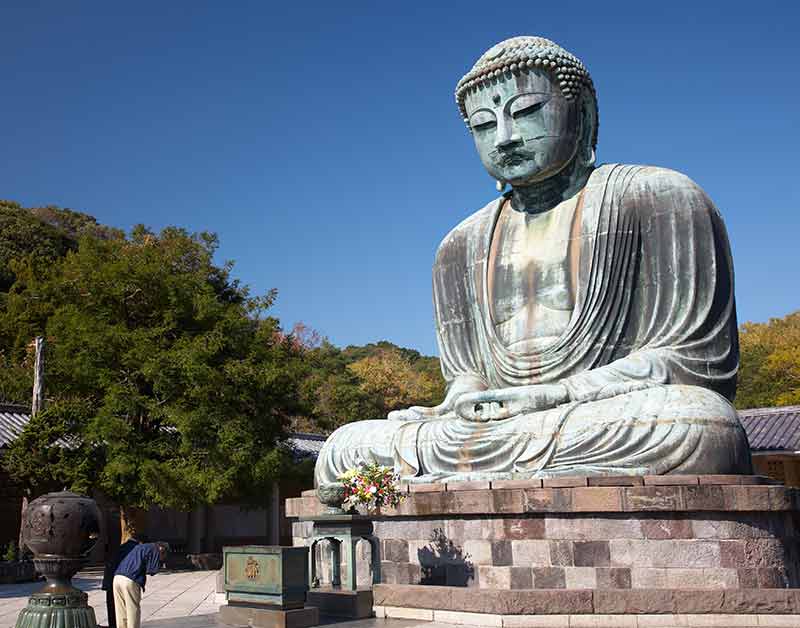
The Kamakura Daibutsu is the second tallest bronze Buddha statue in Japan and one of the most beautiful.
Built in 1252, the 13.35 m statue was in a temple that was swept away in a tsunami in 1498.
The Kamakura Daibutsu now sits in the open on the grounds of Kotoku-in Buddhist temple.
Kamakura Daibutu is at 4-2-28 Hase, Kamakura, Kanagawa and can be visited as a day trip from Tokyo.
21- Miharu Takizakura
Japan is known for its cherry blossoms, so one of the famous natural landmarks in Japan should be a 1000-year-old weeping cherry tree.
Three is over 1000 years old, 12m high and the circumference of the trunk is 9.5m.
Miharu Takizakura is in Fukushima Prefecture in the town of Miharu on Honshu Island.
For more about Japan, read:
- 20 Incredible Landmarks in Japan
- 20 Best Beaches In Japan
- 25 Things To Do In Tokyo At Night
- 25 Landmarks In Tokyo
- A Guide To Winter In Japan
- 50 Things To Do In Japan
- Japan Itinerary (10 days)
- Where To Stay In Tokyo
- Osaka Itinerary
- Nagoya Itinerary
- Where To Stay In Nagoya
- 12 Things To Do in Takayama
- How To Use The Toilets In Japan
- Osaka Itinerary
- 20 Things To Do In Osaka At Night
- Where To Stay In Osaka
- 20 Things To Do In Hiroshima
- Where To Stay In Hiroshima
- 20 Things To Do In Yokohama
- 15 Things Japan Is Famous For
- 20 Things To Do In Kamakura
- 20 Things To Do In Nagano
- 20 Day Trips From Tokyo
- 3 Day Trips From Osaka
- The Most Beautiful Japan Tourist Spots
- Hakuba Hotels
- Hakuba Ski Resort
- Japanese Onsen Tips
- Where To Stay In Kyoto Like A Local
- Arashiyama Monkey Park
- Eating and Drinking Matcha
- Amanemu Review
- 20 Japanese Drinks
- 20 Things To Do In Kyoto At Night
- 20 Japanese Cities
- 20 Things To Do In Fukuoka
- Where To Stay In Fukuoka
- 20 Things To Do In Nara
- 20 Things To Do In Hakone
- 20 Things To Do In Sapporo
- Where To Stay In Sapporo
- 20 Things To Do In Kanazawa
- 20 Things To Do In Okinawa
- 20 Things To Do In Sendai
- 20 Things To Do In Saitama
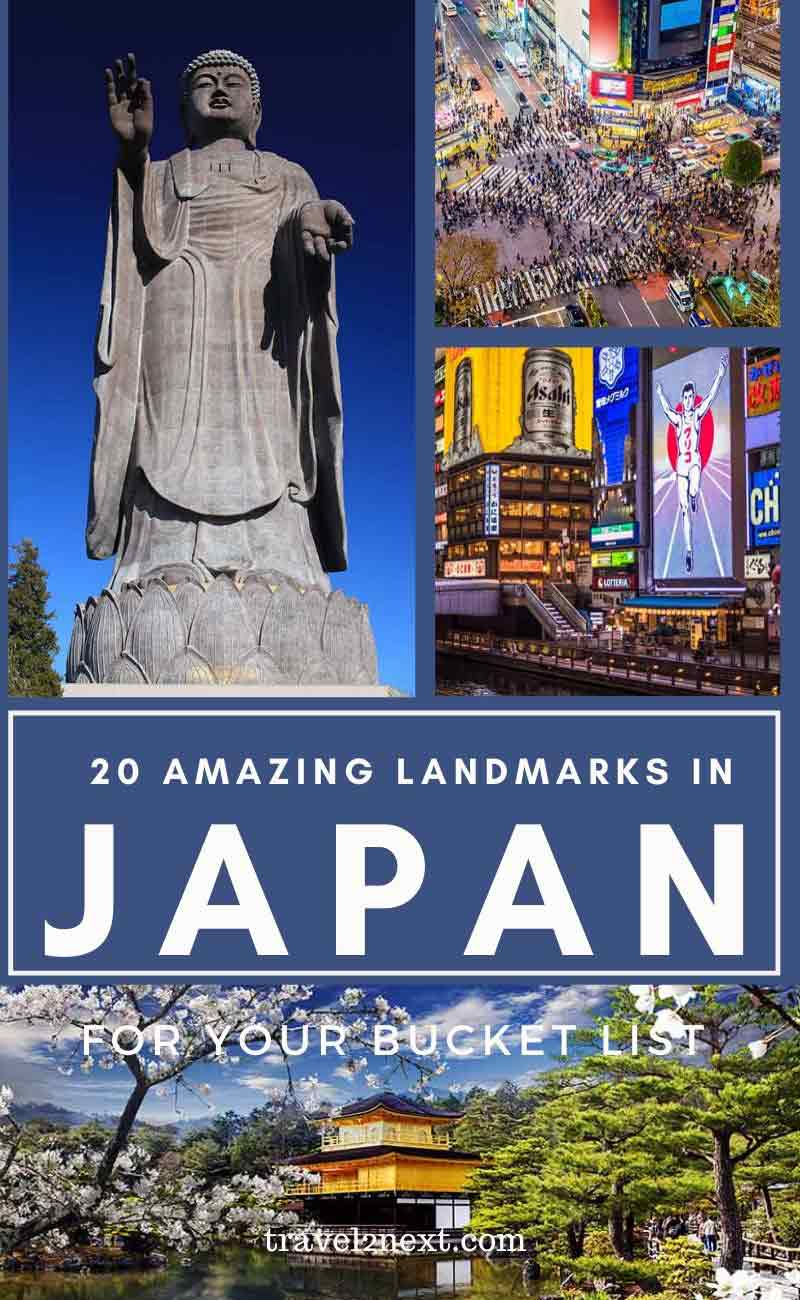

Plan Your Trip

Rent A Car – Find the best car rental rates at Discover Cars. They compare car hire companies to provide you with the best deal right now.

Find A Hotel – If you’re curious about this article and are looking for somewhere to stay, take a look at these amazing hotels.



